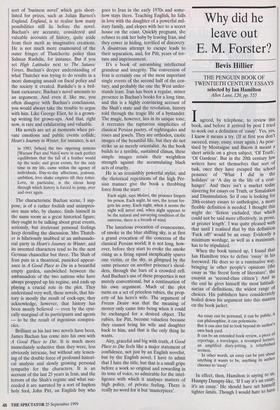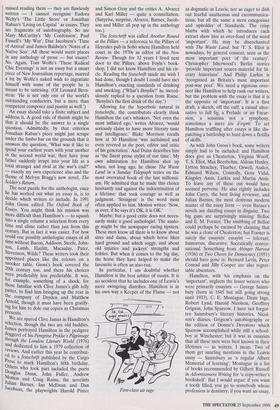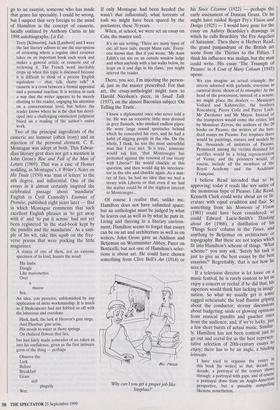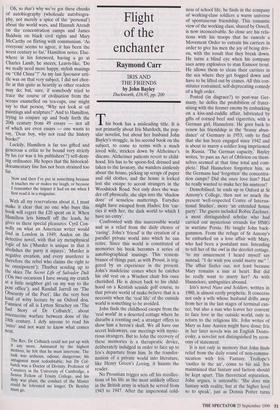Why did he leave out E. M. Forster?
Bevis Hillier
THE PENGUIN BOOK OF TWENTIETH CENTURY ESSAYS selected by Ian Hamilton Allen Lane, £20, pp. 555 Iagreed, by telephone, to review this book, and before it arrived by post I tried to work out a definition of 'essay'. Yes, yes, I know it means a try. (If at first you don't succeed, essay, essay, essay again.) As prac- tised by Montaigne and Bacon it meant a short article on a given subject, 'Of Truth', `Of Gardens'. But in the 20th century few writers have set themselves that sort of task, once they have escaped the school penance of 'What I did in the holidays' or 'A day in the life of a coat- hanger'. And there isn't a market today slavering for essays on Truth, or Simulation and Dissimulation. So if one is looking for 20th-century essays to anthologise, a more flexible definition is needed. I thought this might do: 'fiction excluded, that which could not be said more effectively, in prose, at greater length'. I was quite pleased with that until I realised that by this definition `Fuck off!' would be an essay. Evidently a minimum wordage, as well as a maximum, has to be stipulated. When the book turned up, I found that Ian Hamilton tries to define 'essay' in his foreword. He does so in a ruminative way, bringing in other people's opinions (the essay as 'the freest form of literature', the essayist as 'second-class citizen'). And in the end he gives himself the most latitudi- narian of definitions, the widest range of choices. His publishers have considerately boiled down his argument into this mantra on the book jacket.
An essay can be personal, it can be public, it can philosophise, it can polemicise.
But it can also fail to look beyond its author's own back yard. It can be an extended book review, a piece of reportage, a travelogue, a revamped lecture, an amplified diary-jotting, a refurbished sermon.
In other words, an essay can be just about anything it wants to be, anything its author chooses to 'essay'.
In effect, then, Hamilton is saying to us, Humpty Dumpty-like, 'If I say it's an essay, it's an essay.' He should have set himself tighter limits. Though I would hate to have missed reading them — they are flawlessly written — I cannot recognise Eudora Welty's 'The Little Store' or Jonathan Raban's 'Living on Capital ' as essays. They are fragments of autobiography. So are Mary McCarthy's 'My Confession', Paul Fussell's 'My War', Dan Jacobson's 'Time of Arrival' and James Baldwin's 'Notes of a Native Son'. All these would merit places in any anthology of prose — but essays? No. Again, Tom Wolfe's 'These Radical Chic Evenings' is not an essay but a smart piece of New Journalism reportage, marred a bit by Wolfe's naked wish to ingratiate himself with some of the people he is meant to be satirising. (Of Leonard Bern- stein: 'He is not only one of the world's outstanding conductors, but a more than competent composer and pianist as well.') An essay should take a finite subject and address it. A good rule of thumb might be that it should be the answer to a single question. Admittedly, by that criterion Jonathan Raban's piece might just scrape under the limbo bar on the grounds that it answers the question, 'What was it like to spend your earliest years with your mother in the second world war, then have your father suddenly irrupt into your life as a total stranger and rival at the war's end?' — exactly my own experience also and the theme of Melvyn Bragg's new novel, The Soldier's Return.
The next puzzle for the anthologist, once he has worked out what an essay is, is to decide which writers to include. In 1991 John Gross edited The Oxford Book of Essays. You might think his mission was more difficult than Hamilton's — to squash into a single volume a selection from every time and clime rather than just from this century. But in fact it was easier. For how could one possibly anthologise essays of all time without Bacon, Addison, Steele, John- son, Lamb, Hazlitt, Macaulay, Pater, Stevenson, Wilde? These writers took their appointed places like the colours on a snooker table. Gross's book covered the 20th century too, and there his choices were predictably less predictable. It was, for example, something of a shock, for those familiar with Clive James's glib telly patter, to find him bringing up the rear in the company of Dryden and Matthew Arnold, though it must have been gratify- ing for him to dole out copies as Christmas presents.
We are spared Clive James in Hamilton's selection, though the two are old buddies. James portrayed Hamilton in the pedigree doggerel of his Peregrine Prykke's Pilgrimage through the London Literary World (1976) and dedicated to him a 1979 collection of reviews. And earlier this year he contribut- ed to a festschrift published by the Cargo Press to mark Hamilton's 60th birthday. Others who took part included the poets Douglas Dunn, John Fuller, Andrew Motion and Craig Raine, the novelists Julian Barnes, Ian McEwan and Dan Jacobson, the playwrights Harold Pinter and Simon Gray and the critics A. Alvarez and Karl Miller — quite a constellation. (Surprise, surprise, Alvarez, Barnes, Jacob- son and Miller all pop up in the anthology too.) The festschrift was called Another Round at the Pillars — a reference to the Pillars of Hercules pub in Soho where Hamilton held court in the 1970s as editor of the New Review. Though for 12 years I lived next door to the Pillars, above Foyle's book- shop, I did not know Hamilton and his cir- cle. Reading the festschrift made me wish I had done, though I doubt I could have met Hamilton's exacting standards of drinking and smoking. ('What's Benylin?' he incred- ulously replied to a question from Raine. `Benylin's the first drink of the day.') Allowing for the hyperbole natural in festschrifte, the contributors clearly think Hamilton the cat's whiskers. 'Not even the most inflated ego,' writes Alvarez, 'would seriously claim to have more literary taste and intelligence.' Blake Morrison recalls how at 30 Hamilton 'was acclaimed and even revered as the poet, editor and critic of his generation'. And Dunn describes him as 'the finest prose stylist of our time'. My own admiration for Hamilton shot up when, not long ago, he chose The Waste Land in a Sunday Telegraph series on the most overrated book of the last millenni- um. He admitted that he made this choice hesitantly and against the indoctrination of a lifetime: that took courage as well as judgment. 'Stringent' is the word most often applied to him. Motion writes: 'Now, as ever, if he says it's OK, it is OK.'
Maybe; but a good critic does not neces- sarily make a good anthologist. The analo- gy might be the newspaper racing tipsters. These men know all there is to know about sires and dams, about which horse likes hard ground and which soggy, and about old injuries and jockeys' strengths and foibles. But when it comes to the big day, the horse they have helped to make the favourite is often an also-ran.
In particular, I am doubtful whether Hamilton is the best arbiter of essays. It is no accident that he includes one of Leavis's more swingeing diatribes. Hamilton is in his own way a Keeper of the Flame — not First-class air rage. as dogmatic as Leavis, nor as eager to dish out fearful anathemas and excommunica- tions, but all the same a stern categoriser and upholder of Standards. The crisp blurbs with which he introduces each extract show him as over-fond of the word `important'. He may be disenchanted with The Waste Land, but 'T. S. Eliot is nowadays, by general consent, seen as the most important poet of the century'. Christopher Isherwood's Berlin stories `provide important source-material for lit- erary historians'. And Philip Larkin is `recognised as Britain's most important post-war poet'. We need a rigorous over- seer like Hamilton to help rank our writers, but the problem with the essay is that it is the opposite of 'important'. It is a first draft, a sketch, off the cuff, a casual alter- native to full fig, a Prelude or an Excur- sion, a sonatina not a symphony, sometimes a mere jeu d'esprit. To set Hamilton truffling after essays is like dis- patching a battleship to hunt down a flotilla of skiffs.
As with John Gross's book, some writers simply had to be included: and Hamilton does give us Chesterton, Virginia Woolf, T. S. Eliot, Max Beerbohm, Aldous Huxley, Lytton Strachey, Thurber, Orwell, Auden, Edmund Wilson, Connolly, Gore Vidal, Kingsley Amis, Larkin and Martin Amis. To leave any of these out would have seemed perverse. He also rightly includes John Carey, the best living reviewer, and Julian Barnes, the most dextrous modern master of the essay form — even Barnes's novels are dazzling essays in disguise. Two big guns are surprisingly missing: Belloc and E. M. Forster. The snubbing of Belloc could perhaps be excused by claiming that he was a clone of Chesterton; but Forster is surely the essayists' essayist — tolerant, humorous, discursive, Socratically conver- sational. Something from Abinger Harvest (1936) or Two Cheers for Democracy (1951) should have gone in. Bernard Levin, Peter Conrad and Jilly Cooper are also regret- table absentees.
Hamilton, with his emphasis on the `important', neglects the lesser writers who were primarily essayists — George Saints- bury (born in 1845 but still going strong until 1933), C. E. Montague, Dean Inge, Robert Lynd, Harold Nicolson, Geoffrey Grigson, John Sparrow. I have not forgot- ten Saintsbury's literary histories, Nicol- son's diaries, Grigson's autobiography or the edition of Donne's Devotions which Sparrow accomplished while still a school- boy at Winchester; but it was as essayists that all these men were best known in their lifetimes — as writers, I mean. Two of them get snarling mentions in the Leavis essay — Saintsbury as 'a regular Albert Memorial of learning', Montague in a list of books recommended by Gilbert Russell in Advertisement Writing for 'a copy-writer's bookshelf. But I would argue: if you want a tooth filled, you go to somebody whose profession is dentistry; if you want an essay, go to an essayist, someone who has made that genre his speciality. I could be wrong, but I suspect that very foreign to the mind of Hamilton is the concept of causerie, lucidly outlined by Anthony Curtis in his 1998 autobiography, Lit Ed:
Terry [Kilmartin], Jack [Lambert] and I were the last literary editors to use the star-system of reviewing where a regular chief reviewer takes on an important book each week and makes a general article or causerie out of reviewing it. The French word inevitably crops up when this topic is discussed because it is difficult to think of a precise English equivalent — chat, talk, chatty talk? A causerie is a cross between a formal appraisal and a personal reaction. It is written in such a way that the writer appears to be merely chatting to the reader, engaging his attention on a conversational level, but before the reader knows where he is the chat has devel- oped into a challenging omniscient judgment based on a reading of the author's entire work.
Two of the principal ingredients of the causerie are humour (often irony) and an injection of the personal element. C. E. Montague was adept at both. This Edwar- dian literary gent does not get a mention in John Gross's Rise and Fall of the Man of Letters (1969). That was a case of Homer nodding, as Montague's A Writer's Notes on His Trade (1930) was 'man of letters' to the nth degree, and influential. One of the essays in it almost certainly inspired the celebrated passage about 'mandarin' English in Cyril Connolly's Enemies of Promise, published eight years later — that in which Montague comments that such excellent English phrases as 'to get away with it' and to put it across' had not yet been registered 'in the stud-book kept by the pundits and the mandarins'. As a sam- ple of his wit, take this squib on the free- verse poems that were pocking the little magazines:
A stanza of one of them, not an extreme specimen of its kind, haunts the mind: His limbs Dangle Like marionettes Over a mauve Sea.
An idea, you perceive, unblemished by any application of mere workmanship. It is much as if Shakespeare had not fobbed us off with the laborious and overdone Hark, hark, the lark at Heaven's gate sings, And Phoebus 'gins arise, His steeds to water at those springs On chaliced flowers that lies, but had fairly made comrades of us, taken us into his confidence, given us the first intimate germ of the thing — perhaps Observe the Lark Before Breakfast Grass still plaguily Wet.
If only Montague had been heeded (he wasn't that influential), what torrents of tosh we might have been spared by the poetasters, these 70 years.
When, at school, we were set an essay on Cats, the master said: It's no use writing, 'There are many types of cat; all have tails, except Manx cats.' Every- one knows that. But if you wrote, 'My Aunt Edith's cat sits on an outside window ledge and when anybody with a hat walks below, he leaps on it and digs in his claws,' you might interest the reader.
There, you see, I'm injecting the person- al, just as the master prescribed. For that art, the essay-anthologist might turn to Harold Nicolson's piece, in Small Talk (1937), on the almost Baconian subject 'On Telling the Truth'.
I knew a diplomatist once who never told a lie. He was an eccentric little man dressed in grey flannels, who smoked endless pipes. He wore large round spectacles behind which he concealed his eyes, and he had a habit of digging people in the ribs. On the whole, I think, he was the most untruthful man that I ever met. 'Is it true,' someone would ask him, 'that Montenegro has protested against the renewal of our treaty with Liberia?' He would chuckle at this question, and then would dig his interlocu- tor in the ribs and chuckle again. As a mat- ter of fact, he had no idea that we had a treaty with Liberia or that even if we had the matter could be of the slightest interest to Montenegro...
Of course I realise that, unlike me, Hamilton does not have unlimited space; but an anthologist must be judged by what he leaves out as well as by what he puts in. Living and thriving in a literary environ- ment, Hamilton seems to forget that essays can be on art and architecture as well as on writers. John Gross gave us Addison and Betjeman on Westminster Abbey, Pater on Botticelli; but not one of Hamilton's selec- tions is about art. He could have chosen something from Clive Bell's Art (1914) or `Why can't you get a proper job like Sisyphus?' his Since Cezanne (1922) — perhaps the early assessment of Duncan Grant. Or he might have raided Roger Fry's Vision and Design (1925) — I would have gone for the essay on Aubrey Beardsley's drawings in which he calls Beardsley 'the Fra Angelico of Satanism'. Then there is Herbert Read, the grand panjandrum of the British art scene from the Thirties to the Fifties. think his influence was malign, but the man could write. His essay 'The Triumph of Picasso' in A Coat of Many Colours (1945) opens:
We can imagine an actual. triumph: the streets adorned with garlands, everyone in carnival dress, shouts of Io triumphei At the head of the procession, instead of a senate, we might place the dealers — Messieurs Vollard and Kahnweiler, the brothers Rosenberg, Pierre Colle and Pierre Loeb, Mr Zwemmer and Mr Mayor. Instead of the trumpeters would come the critics, led by Monsieur Zervos, the authors of the 20 books on Picasso, the writers of the hun- dred essays on Picasso. For trophies there would be paintings, statues and models by the thousands of imitators of Picasso. Prominent among the victims destined for sacrifice would be a living representation of Venus, and the prisoners would, of course, include all the members of the Royal Academy and the Academic Frangaise.
I believe Read intended that to be approving; today it reads like wry satire of the monstrous hype of Picasso. Like Read, Kenneth Clark could write about art or lit- erature with equal erudition and flair. So something from his Moments of Vision (1981) could have been considered; so could Edward Lucie-Smith's Thinking about Art (1968), a distillation of his `Things Seen' column in the Times, and anything by Betjeman on architecture or topography. But these are not topics which fit into Hamilton's scheme of things. 'What scheme?' you may ask. 'Surely his task is just to give us the best essays by the best essayists?' Regrettably, that is not how he sees it.
If a television director is let loose on a music festival, he is rarely content to let us enjoy a concert or recital: if he did that, his superiors would think him lacking in image nation. So what we usually get is some ragged rehearsals; the lead flautist griping about the conductor; stormy discussions about budgeting; snide or glowing opinions from musical pundits and gaucher ones from the audience; and, if we're lucky, Just a few short bursts of actual music. Similar- ly, Hamilton has not been content just to go out and corral for us the best represen- tative selection of 20th-century essays to enjoy; there has to be an angle, a binding leitmotiv.
I have tried to organise the essays in this book [he writes] so that, decade by decade, a portrayal of the century shows through: a portrayal with gaps, and of course a portrayal done from an Anglo-American perspective, but a passably compelling likeness, nonetheless. Oh, so that's why we've got these chunks of autobiography (wholesale autobiogra- phy, not merely a spice of the 'personal') about the world wars, and Hannah Arendt on the concentration camps and James Baldwin on black civil rights and Mary McCarthy on flirting with communism. 'As everyone seems to agree, it has been the worst century so far,' Hamilton notes. Else- where in his foreword, having a go at Charles Lamb, he sneers, Leavis-like, `Do we really need more happy, stylish musings on "Old China"?' As my last Spectator arti- cle was on that very subject, I did not chor- tle at this quite as heartily as other readers may do; but, sure, if somebody tried to trace the course of civilisation from the scenes enamelled on tea-cups, one might say to that person, 'Why not look at oil paintings and sculpture?' And to Hamilton, trying to conjure up and body forth the 20th century from 49 essays — not all of which are even essays — one wants to say, 'Dear boy, why not read the history books?'
Luckily, Hamilton is far too gifted and generous a critic to be bound very strictly by his (or was it his publishers'?) self-deny- ing ordinance. He hopes that the historical- documentary line has not been strained too far.
Now and then I've put in something because it touches me or makes me laugh, or because I remember the impact it had on me when I first read it in a magazine.
With all my reservations about it, I must make it clear that no one who buys this book will regret the £20 spent on it. When Hamilton lets himself off the leash, he gives us these special pleasures: Cyril Con- nolly on what an American writer would find in London in 1949; Auden on the detective novel, with that icy metaphysical logic of his (`Murder is unique in that it abolishes the party it injures'; 'Murder is negative creation, and every murderer is therefore the rebel who claims the right to be omnipotent'); Thurber sending up to the skies The Secret Life of Salvador Dali (`On two occasions I have swung my crutch at a little neighbor girl on my way to the post office'); and Randall Jarrell on 'The Obscurity of the Poet', like the very best kind of witty lecture by an Oxford don. Funniest of all is Lytton Strachey on 'The Sad Story of Dr Colbatch', about Internecine warfare between dons of the 18th century. I defy anyone to read his `intro' and not want to know what comes next.
The Rev. Dr Colbatch could not put up with it any more. Animated by the highest motives, he felt that he must intervene. The task was arduous, odious, dangerous; his antagonist most redoubtable; but Dr Col- batch was a Doctor of Divinity, Professor of Casuistry in the University of Cambridge, a Senior Fellow of Trinity College, and his duty was plain; the conduct of the Master could be tolerated no longer; Dr Bentley must go.





























































































 Previous page
Previous page